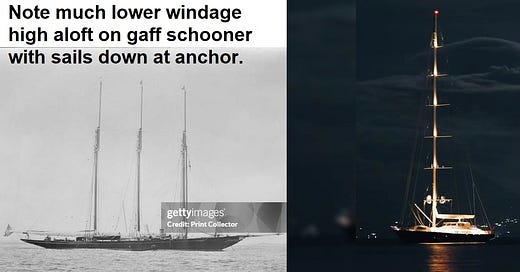Bayesian, the mega sailing yacht that sank last week by Sicily, was a disaster waiting to happen. Here's why.
Modern high-tech composite materials and rigging allow super-high single-masted sloops that were impossible to build in the old schooner era. An advantage of the old schooners was that with their sails down, there was much less windage far aloft. For a modern giant super-sloop, the windage aloft, even at anchor, is tremendous. All of those spreaders plus the mast surface area present a massive amount of windage when subjected to a blast of wind. The enormous height causes vastly more leverage than the same wind striking a "low aspect ratio" sailing rig. At anchor, deck hatches would be open. If the boat is heeled over far enough to put open side deck hatches underwater, down-flooding and sinking would happen in a matter of a minute or two.
To have a safe righting moment even after being knocked down with her mast horizontal and in the water, Bayesian would have needed a ballast keel 40 or so feet deep. This is not practical, so mega sailboats rely on inertia and mass to not get knocked all the way down. If they are knocked down, they are basically doomed if any hatches are open. There is no ballast keel sufficient to lever them back upright.
Bayesian had HUGE windage, and very high up. Even with her sails down and roller jibs furled, the 237' tall mast is (estimating from photos) almost five feet front to back, and she had 6 sets of "spreaders" that are almost the size of a Cessna's wings. Once she's heeled 45* by the sudden wind blast catching her on her beam, she didn't shed the wind, she caught even more on her spreaders. Her roller furling jibs are also massive, about a yard in diameter even when furled.
A sloop is the most efficient sailing rig in terms of potential lift to drag. 2 sails, one mast. But that enormous mast is always way, way up there. An old gaff schooner at anchor would present much less windage. But any giant sailing ship relying on mass and inertia to avoid being knocked down was and is always at risk. Another "safety factor" present in older sailing ships was that their organic-fiber sails and ropes would tend to "blow out" when struck by a wind blast, instead of taking the ship all the way over. Even being dismasted was preferable to being knocked down and sunk. With today's modern sails and rigging, the sails won't fail, and the sailing ship will be driven over on her beam end.
White Squall 1996 Trailer | Jeff Bridges
This is a movie recounting when a sailing ship was knocked down by a "white squall" and sank in minutes with the loss of life.
This also happened to the 90' Pride of Baltimore #1, in 1986 under full sail on the Atlantic.
A schooner being knocked down in a storm also occurs in my new novel, Doomsday Reef.
https://www.amazon.com/Doomsday-Reef-Matthew-Bracken/dp/0








When I heard the initial news reports refer to the ship's "240-foot" mast", I thought that must be a mistake...
Amazing - I actually understood all that.